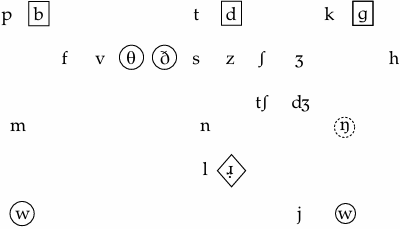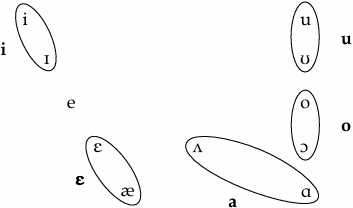


 Grammar
Grammar
 Tenses
Tenses
 Present
Present
 Past
Past
 Future
Future
 Parts Of Speech
Parts Of Speech
 Nouns
Nouns
 Verbs
Verbs
 Adverbs
Adverbs
 Adjectives
Adjectives
 Pronouns
Pronouns
 Pre Position
Pre Position
 Preposition by function
Preposition by function 
 Preposition by construction
Preposition by construction
 Conjunctions
Conjunctions
 Interjections
Interjections
 Grammar Rules
Grammar Rules
 Linguistics
Linguistics
 Semantics
Semantics
 Pragmatics
Pragmatics
 Reading Comprehension
Reading Comprehension|
Read More
Date: 2025-03-13
Date: 2023-11-06
Date: 16-4-2022
|
Turkish–English
The overlay of the native language consonantal system onto the target English inventory results in the following:

From the consonantal inventory, we can easily see potential troubles for the missing English targets /θ, ð, w, ŋ/, which manifest themselves in thin → [tin], they → [de]. Although there is also no /ŋ/ in the consonantal inventory of Turkish, [ŋ] is phonetically present in Turkish before velar stops, as in Ankara [aŋkaɾa], banka “bank” [baŋka]. Also, while [v] is used for the missing target /w/ (e.g. well → [vεl]) this problem is not present intervocalically, as /v/ has a [w] allophone in this position.
Non-continuant obstruents (i.e. stops and affricates) have voicing contrasts in initial and medial positions; in final position, however, we find only the voice less members of these pairs. This is the source of substitutions, for example, in bag → [bεk], bid → [bit]. The progressive ending -ing [ɪŋ] creates a problem, which can be accounted for in two steps. Since [ŋ] in Turkish requires the presence of a following velar stop, and the velar stop in final position cannot be anything other than the voiceless variant, the rendition of -ing [ɪŋ] is [ɪŋk], as in going [goɪŋk].
Significant phonetic differences are relevant to liquids, especially for the non-lateral target retroflex approximant. The Turkish r-sound is an alveolar tap, /ɾ/. In addition, it is produced voiceless (and with friction) in final position (e.g. [kaɾ̥] “snow”). The alveolar lateral has both the ‘clear’ and the ‘dark’ variants, although their distributions are different from those of English and create mismatches. All word-initial laterals and all coda laterals after front vowels are ‘clear’ (cf. English ‘dark’ realizations in lawn and sell).
The conflicts in vowels involve several insufficient separations of contrasting English pairs /i/ – /ɪ/ (e.g. peach– pitch), /ε/ – /æ/ (e.g. mess– mass), /Λ/ – /ɑ/ (e.g. buddy– body), /u/ – /ʊ/ (e.g. fool– full), which are summarized in the following chart:

Other Turkish vowels not relevant for mismatches are /y, ø, ա/.
The syllable structure of Turkish can be described as (C) V (C) (C). There are no initial clusters. The language does allow certain double codas, which can be described as “C1 = sonorant and C2 = obstruent, or C1 = fricative and C2 = stop”. Because of great differences between these clusters and those of English, all target onset clusters, all triple codas, and several double codas expectedly create problems.
Coming from a syllable-timed language, Turkish speakers are expected to have difficulties with English vowel reductions and with rhythm. In addition, the stress patterns of the two languages are significantly different and prove to be sources of difficulty.
The following summarizes the major trouble spots:
• missing target phonemes: /θ/ → [t], /ð/ → [d], /w/ → [v] (except in V_V), /ŋ/→ [n] (except before a velar stop);
• final devoicing of non-continuant obstruents /b, d, g, ʤ/;
• significant phonetic differences: liquids, especially the non-lateral;
• under-differentiation of certain target vowel contrasts;
• onset and coda clusters;
• stress;
• rhythm.
|
|
|
|
دخلت غرفة فنسيت ماذا تريد من داخلها.. خبير يفسر الحالة
|
|
|
|
|
|
|
ثورة طبية.. ابتكار أصغر جهاز لتنظيم ضربات القلب في العالم
|
|
|
|
|
|
|
العتبة العباسية المقدسة تدعو جامعة ديالى للمشاركة في حفل التخرج المركزي الخامس
|
|
|